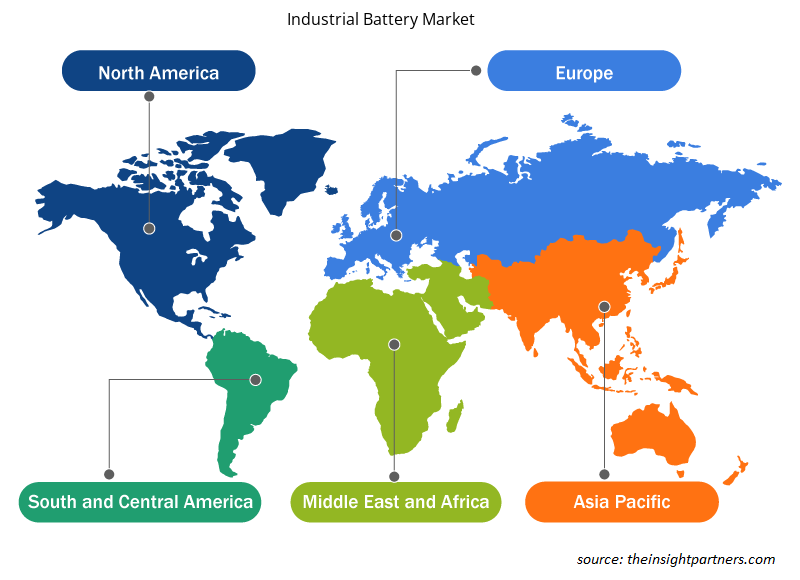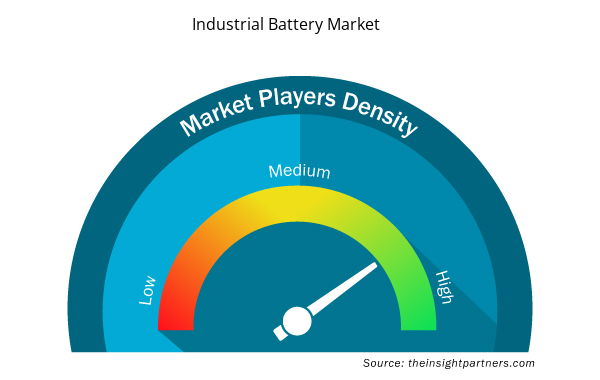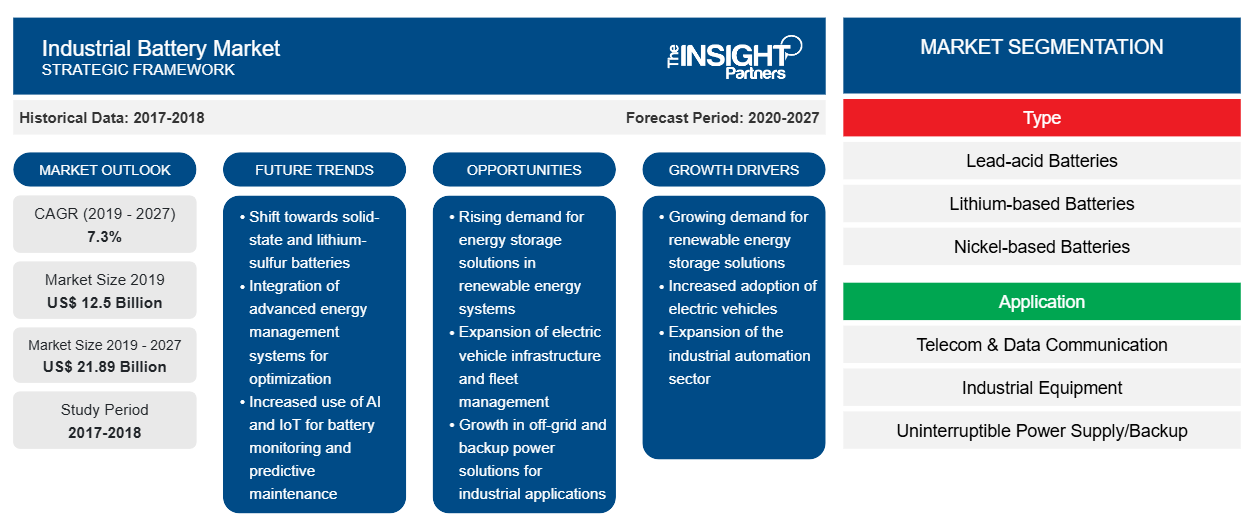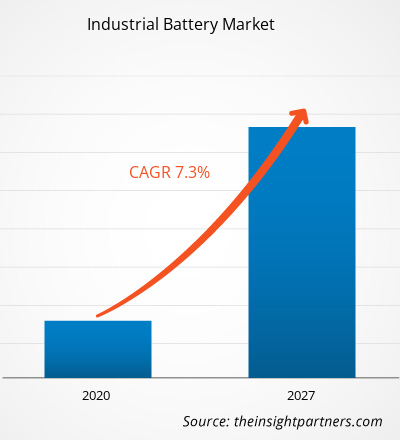بلغت قيمة سوق البطاريات الصناعية 12،501.9 مليون دولار أمريكي في عام 2019 ومن المتوقع أن تنمو بمعدل نمو سنوي مركب قدره 7.3٪ من عام 2020 إلى عام 2027 لتصل إلى 21،893.5 مليون دولار أمريكي بحلول عام 2027.
البطاريات الصناعية هي بطاريات مصممة خصيصًا يمكنها العمل في درجات حرارة صناعية قاسية مثل درجات الحرارة القصوى والمزيد من الاهتزازات والاستخدام المكثف. تعمل البطاريات الصناعية على توفير الطاقة وهي مصممة لتكون أكثر قوة. في سيناريو السوق الحالي، تعمل الشركات بجدية نحو تطوير بطاريات عالية الكفاءة تلبي احتياجات البطاريات الصناعية المتنوعة. من المتوقع أن يشهد سوق البطاريات الصناعية العالمي نموًا مذهلاً خلال فترة التوقعات. من المتوقع أن ينمو الطلب على البطاريات القائمة على الليثيوم بشكل كبير خلال فترة التوقعات. من المتوقع أن ينمو استخدام بطاريات الليثيوم عبر مختلف القطاعات الرأسية نظرًا للمزايا التي توفرها، مثل الانبعاثات المنخفضة، ودورة الحياة المتزايدة، وإمكانية إعادة التدوير. تركز الشركات العاملة في السوق على تطوير منتجات جديدة لكسب قاعدة عملاء قوية وتحقيق حصة سوقية كبيرة.
تتخذ الحكومات في دول أمريكا الشمالية، مثل الولايات المتحدة، خطوات مستمرة لتعزيز إنتاجية صناعة التصنيع. مثل توفير أحدث التقنيات لتسهيل عملية التصنيع وزيادة عدد المستودعات. ومن المتوقع أن يؤثر استخدام التقنيات الآلية في هذه المستودعات على نمو سوق البطاريات الصناعية في أمريكا الشمالية. يؤدي الإنفاق المتزايد من قبل الحكومة نحو تطوير أي تقنية. في منطقة أمريكا الشمالية، فإن الإنفاق الحكومي على أنشطة التقدم التكنولوجي مرتفع للغاية، مما يجعل المناخ مواتياً لأي عمل تجاري للازدهار. شهدت إنترنت الأشياء والبيانات الضخمة والتقنيات المتقدمة تبنيًا كبيرًا في هذه المنطقة. تعمل هذه التقنيات بدورها على تغذية متطلبات الشبكة المحسنة بالإضافة إلى الطلب على البطاريات الصناعية. من التقنيات الناشئة القليلة في سوق البطاريات الصناعية بطاريات الليثيوم أيون (Li-ion) من الجيل الجديد، وبطاريات الليثيوم والكبريت، والبطاريات الصلبة، وبطاريات الألومنيوم أيون، إلخ.
قم بتخصيص هذا التقرير ليناسب متطلباتك
ستحصل على تخصيص لأي تقرير - مجانًا - بما في ذلك أجزاء من هذا التقرير، أو تحليل على مستوى الدولة، وحزمة بيانات Excel، بالإضافة إلى الاستفادة من العروض والخصومات الرائعة للشركات الناشئة والجامعات
- احصل على أهم اتجاهات السوق الرئيسية لهذا التقرير.ستتضمن هذه العينة المجانية تحليلاً للبيانات، بدءًا من اتجاهات السوق وحتى التقديرات والتوقعات.
رؤى السوق
الحلول المتصلة بالشبكة لإمدادات الطاقة غير المنقطعة تدفع الطلب على البطاريات الصناعية
إن أبرز أنواع مصادر الطاقة المتجددة وأكثرها أهمية هي الطاقة الشمسية وطاقة الرياح التي يتم تخزينها في الشبكة. ومع ذلك، فإن تغطية الشمس بالغيوم أو التقلبات في تيار الرياح قد تؤدي إلى اختلافات في عملية توليد الطاقة. تخلق مثل هذه التغييرات الحاجة إلى أنظمة شبكة مرنة لتخزين الطاقة. تساعد أنظمة تخزين طاقة البطاريات الصناعية مشغلي الشبكة على توفير الكهرباء عندما تتجاوز كمية الطاقة الطلب على الكهرباء. وبالتالي، فإن التبني المتزايد لهذه الأنظمة يساعد في تحسين موثوقية ومرونة نظام إمداد الكهرباء فيما يتعلق بأنشطة التوليد والنقل والتوزيع. أثناء النقل والتوزيع، تتعامل أنظمة تخزين طاقة البطاريات مع جوانب مختلفة مثل تأجيل الأصول وقمع التوافقيات ودعم الجهد وتنظيم التردد وجودة الطاقة. إن التحول الزمني للطاقة الكهربائية، والتحول الزمني للطاقة المتجددة، وتسوية الحمل الأساسي، وتقليص الذروة، وتعزيز قدرة الطاقة المتجددة هي الفوائد الأخرى لاستخدام أنظمة تخزين طاقة البطاريات للحلول المتصلة بالشبكة، والتي تدفع تبني هذه الأنظمة، وبالتالي تغذية نمو سوق البطاريات الصناعية. يبتكر اللاعبون في السوق حلولاً جديدة للشبكة للحفاظ على ميزة تنافسية في سوق البطاريات الصناعية. على سبيل المثال، تقدم شركة سيمنز نظام SIESTORAGE، وهو حل ذكي للشبكات. ويستطيع نظام SIESTORAGE التغلب على التحديات التي تظهر خلال الجوانب الثلاثة الرئيسية لإمدادات الطاقة، أي تحسين توصيلات الشبكة، وتوفير الطاقة المرنة للشبكات الحديثة، ودعم كبار مستهلكي الطاقة. وعلاوة على ذلك، في يوليو 2015، عرضت شركة EDP Distribuicao على شركة SIESTORAGE التابعة لشركة سيمنز في إيفورا (البرتغال) مناقصة Storage InovGrid. ويوفر نظام SIESTORAGE خدمات مثل تنظيم الجهد، وتوفير الطاقة الاحتياطية، وتقليل فترات الذروة في استقرار شبكة EDP، ويكرر فوائد الشبكات الذكية لمشغلي الشبكة.
رؤى النوع
في قطاع النوع، استحوذت بطاريات الرصاص الحمضية على أكبر حصة في سوق البطاريات الصناعية العالمية. تتميز بطارية الرصاص الحمضية بتكلفة منخفضة وأداء عالٍ، ويمكن إعادة تدويرها بسهولة، كما أنها سهلة الشحن. إن استخدام بطارية الرصاص الحمضية واسع النطاق نظرًا لتكلفتها المنخفضة وعمر الخدمة الطويل. ومع ذلك، فإن البطارية لن تكون مناسبة للحمل العالي المستمر؛ كما أن كثافة الطاقة الحجمية لديها أقل نسبيًا، مما يجعل استخدامها غير ممكن قليلاً لتطبيقات إدارة الطاقة؛ وبالتالي فهي تستخدم بشكل أساسي لتطبيقات الطاقة. لا تزال التطورات في هذه البطارية على المسار الصحيح، مما قد يسمح لها بأن تصبح خيارًا أكثر جدوى لإدارة الطاقة.
رؤى التطبيق
يتم تقسيم سوق البطاريات الصناعية، حسب التطبيق، إلى الاتصالات السلكية واللاسلكية واتصالات البيانات والمعدات الصناعية وإمدادات الطاقة غير المنقطعة (UPS)/النسخ الاحتياطي والتعدين والبحرية وغيرها. استحوذ قطاع المعدات الصناعية على حصة مهيمنة في سوق البطاريات الصناعية العالمية. تشير اتجاهات الصناعة 4.0 المتنامية، مثل إنترنت الأشياء والذكاء الاصطناعي وتحليل البيانات الضخمة والاتصالات الشبكية والحوسبة السحابية وتقنيات التعلم الآلي، إلى تغيير كبير في طريقة عمل الشركات وكيفية تفاعلها مع عملائها. تقدم مثل هذه التقنيات المتنامية حلول معدات صناعية مبتكرة تدعم إنتاج وتسليم معدات فعالة.
تتبنى الشركات عادة استراتيجية الدمج والاستحواذ لتوسيع نطاق وجودها في جميع أنحاء العالم وتلبية الطلب المتزايد. وتُتبع هذه الاستراتيجية في الغالب في أمريكا الشمالية وأوروبا. ويتبنى اللاعبون الموجودون في سوق البطاريات الصناعية استراتيجية التوسع والاستثمار في البحث والتطوير لتوسيع قاعدة العملاء في جميع أنحاء العالم، مما يسمح أيضًا للاعبين بالحفاظ على اسم علامتهم التجارية عالميًا. وفيما يلي بعض عمليات الاستحواذ الأخيرة؛
2019: أعلنت شركة East Penn عن الاستحواذ على حصة الأغلبية في شركة Navitas Systems. ومن المتوقع أن يدعم هذا الاستحواذ توسعة عروض Motive Power Battery.
2019: أعلنت شركة Saft عن الاستحواذ على 100% من أسهم شركة Go Electric Inc.، وهي شركة مقرها الولايات المتحدة تعمل على تطوير حلول مرونة الطاقة الموزعة للشبكات الصغيرة والعملاء التجاريين والصناعيين.
رؤى إقليمية حول سوق البطاريات الصناعية
لقد قام المحللون في Insight Partners بشرح الاتجاهات والعوامل الإقليمية المؤثرة على سوق البطاريات الصناعية طوال فترة التوقعات بشكل شامل. يناقش هذا القسم أيضًا قطاعات سوق البطاريات الصناعية والجغرافيا في جميع أنحاء أمريكا الشمالية وأوروبا ومنطقة آسيا والمحيط الهادئ والشرق الأوسط وأفريقيا وأمريكا الجنوبية والوسطى.

- احصل على البيانات الإقليمية المحددة لسوق البطاريات الصناعية
نطاق تقرير سوق البطاريات الصناعية
| سمة التقرير | تفاصيل |
|---|---|
| حجم السوق في عام 2019 | 12.5 مليار دولار أمريكي |
| حجم السوق بحلول عام 2027 | 21.89 مليار دولار أمريكي |
| معدل النمو السنوي المركب العالمي (2019 - 2027) | 7.3% |
| البيانات التاريخية | 2017-2018 |
| فترة التنبؤ | 2020-2027 |
| القطاعات المغطاة | حسب النوع
|
| المناطق والدول المغطاة | أمريكا الشمالية
|
| قادة السوق وملفات تعريف الشركات الرئيسية |
|
كثافة اللاعبين في سوق البطاريات الصناعية: فهم تأثيرها على ديناميكيات الأعمال
يشهد سوق البطاريات الصناعية نموًا سريعًا، مدفوعًا بالطلب المتزايد من المستخدم النهائي بسبب عوامل مثل تفضيلات المستهلكين المتطورة والتقدم التكنولوجي والوعي المتزايد بفوائد المنتج. ومع ارتفاع الطلب، تعمل الشركات على توسيع عروضها والابتكار لتلبية احتياجات المستهلكين والاستفادة من الاتجاهات الناشئة، مما يؤدي إلى زيادة نمو السوق.
تشير كثافة اللاعبين في السوق إلى توزيع الشركات أو المؤسسات العاملة في سوق أو صناعة معينة. وهي تشير إلى عدد المنافسين (اللاعبين في السوق) الموجودين في مساحة سوق معينة نسبة إلى حجمها أو قيمتها السوقية الإجمالية.
الشركات الرئيسية العاملة في سوق البطاريات الصناعية هي:
- شركة سي اند دي للتكنولوجيا
- شركة تصنيع شرق بن
- إنيرسيس
- شركة إكسايد للصناعات المحدودة
- شركة جنرال الكتريك
إخلاء المسؤولية : الشركات المذكورة أعلاه ليست مرتبة بأي ترتيب معين.

- احصل على نظرة عامة على أهم اللاعبين الرئيسيين في سوق البطاريات الصناعية
سوق البطاريات الصناعية – حسب النوع
- بطاريات الرصاص الحمضية
- بطاريات تعتمد على الليثيوم
- البطاريات القائمة على النيكل
- آحرون
سوق البطاريات الصناعية – حسب التطبيق
- الاتصالات السلكية واللاسلكية ونقل البيانات
- المعدات الصناعية
- UPS/النسخ الاحتياطي
- تخزين الطاقة على مستوى الشبكة
- التعدين
- بحري
- آحرون
السوق العالمية للبطاريات الصناعية حسب المنطقة
أمريكا الشمالية
- نحن
- كندا
- المكسيك
أوروبا
- فرنسا
- ألمانيا
- إيطاليا
- المملكة المتحدة
- روسيا
- بقية أوروبا
آسيا والمحيط الهادئ
- الصين
- الهند
- كوريا الجنوبية
- اليابان
- أستراليا
- بقية آسيا والمحيط الهادئ
الشرق الأوسط وأفريقيا
- جنوب أفريقيا
- المملكة العربية السعودية
- الامارات العربية المتحدة
- بقية الشرق الأوسط وأفريقيا
أمريكا الجنوبية
- البرازيل
- الأرجنتين
- بقية أمريكا الجنوبية
ملفات تعريف الشركات
- شركة سي اند دي للتكنولوجيا
- شركة تصنيع شرق بن
- إنيرسيس
- شركة إكسايد للصناعات المحدودة
- شركة جنرال الكتريك
- شركة جي اس يواسا الدولية المحدودة
- إل جي كيم
- شركة باناسونيك
- شركة روبرت بوش المحدودة
- مجموعة صفط SA
- التحليل التاريخي (سنتان)، السنة الأساسية، التوقعات (7 سنوات) مع معدل النمو السنوي المركب
- تحليل PEST و SWOT
- حجم السوق والقيمة / الحجم - عالميًا وإقليميًا وقطريًا
- الصناعة والمنافسة
- مجموعة بيانات Excel



Report Coverage
Revenue forecast, Company Analysis, Industry landscape, Growth factors, and Trends

Segment Covered
This text is related
to segments covered.

Regional Scope
North America, Europe, Asia Pacific, Middle East & Africa, South & Central America

Country Scope
This text is related
to country scope.
الأسئلة الشائعة
The Industrial Equipment sector is the leading industry in the market, which comprises machinery, large scale process, and construction industry plants. The growing industry 4.0 trends, such as IoT, Artificial Intelligence (AI), big data analysis, networked communications, cloud computing, and machine learning technologies, are marking a substantial change in the businesses model and the way of attracting customers. Such growing technologies are offering innovative industrial equipment solutions that support the production and delivery of efficient equipment. In order to operate a warehouse or heavy machinery, the need for material handling equipment batteries is necessary. Lithium-ion batteries are ideally used for the equipment used in various industries, such as food and beverage and tissue industries. Increasing use of industrial equipment in areas such as airport ground support, lift trucks, sweepers, and scrubbers, and automatic guided vehicles (AGV) is propelling the growth of industrial battery market.
The APAC region led the Industrial Battery market in 2019 as the factors such as the growing industrial equipment, mining, and marine industries, stringent environmental regulations, and reduced labor costs associated with battery recycling are the factors boosting the APAC industrial battery market growth.
Governments across the world are focusing on expanding the reach of digitization and promoting the utilization of several electronic devices, and have become the most important storage technology in the areas of portable and mobile applications (e.g., laptop, cell phone, electric bicycle, and electric car). Other important uses of lithium-ion batteries include storage in electrical grids. Moreover, the performance of Lithium-ion batteries (LIBs) used in grid-level energy storage systems is analyzed by service providers with regard to frequency regulation, peak shifting, integration with renewable energy sources, and power management. The increasing requirement of lithium-ion batteries in various applications is one of the major factors driving the industrial battery market.
Trends and growth analysis reports related to Manufacturing and Construction : READ MORE..
The List of companies - Industrial Battery Market
- C&D Technologies, Inc.
- East Penn Manufacturing Company
- EnerSys
- Exide Industries Limited
- General Electric Company
- GS Yuasa International Ltd.
- LG Chem
- Panasonic Corporation
- Robert Bosch GmbH
- Saft Groupe SA
The Insight Partners performs research in 4 major stages: Data Collection & Secondary Research, Primary Research, Data Analysis and Data Triangulation & Final Review.
- Data Collection and Secondary Research:
As a market research and consulting firm operating from a decade, we have published and advised several client across the globe. First step for any study will start with an assessment of currently available data and insights from existing reports. Further, historical and current market information is collected from Investor Presentations, Annual Reports, SEC Filings, etc., and other information related to company’s performance and market positioning are gathered from Paid Databases (Factiva, Hoovers, and Reuters) and various other publications available in public domain.
Several associations trade associates, technical forums, institutes, societies and organization are accessed to gain technical as well as market related insights through their publications such as research papers, blogs and press releases related to the studies are referred to get cues about the market. Further, white papers, journals, magazines, and other news articles published in last 3 years are scrutinized and analyzed to understand the current market trends.
- Primary Research:
The primarily interview analysis comprise of data obtained from industry participants interview and answers to survey questions gathered by in-house primary team.
For primary research, interviews are conducted with industry experts/CEOs/Marketing Managers/VPs/Subject Matter Experts from both demand and supply side to get a 360-degree view of the market. The primary team conducts several interviews based on the complexity of the markets to understand the various market trends and dynamics which makes research more credible and precise.
A typical research interview fulfils the following functions:
- Provides first-hand information on the market size, market trends, growth trends, competitive landscape, and outlook
- Validates and strengthens in-house secondary research findings
- Develops the analysis team’s expertise and market understanding
Primary research involves email interactions and telephone interviews for each market, category, segment, and sub-segment across geographies. The participants who typically take part in such a process include, but are not limited to:
- Industry participants: VPs, business development managers, market intelligence managers and national sales managers
- Outside experts: Valuation experts, research analysts and key opinion leaders specializing in the electronics and semiconductor industry.
Below is the breakup of our primary respondents by company, designation, and region:

Once we receive the confirmation from primary research sources or primary respondents, we finalize the base year market estimation and forecast the data as per the macroeconomic and microeconomic factors assessed during data collection.
- Data Analysis:
Once data is validated through both secondary as well as primary respondents, we finalize the market estimations by hypothesis formulation and factor analysis at regional and country level.
- Macro-Economic Factor Analysis:
We analyse macroeconomic indicators such the gross domestic product (GDP), increase in the demand for goods and services across industries, technological advancement, regional economic growth, governmental policies, the influence of COVID-19, PEST analysis, and other aspects. This analysis aids in setting benchmarks for various nations/regions and approximating market splits. Additionally, the general trend of the aforementioned components aid in determining the market's development possibilities.
- Country Level Data:
Various factors that are especially aligned to the country are taken into account to determine the market size for a certain area and country, including the presence of vendors, such as headquarters and offices, the country's GDP, demand patterns, and industry growth. To comprehend the market dynamics for the nation, a number of growth variables, inhibitors, application areas, and current market trends are researched. The aforementioned elements aid in determining the country's overall market's growth potential.
- Company Profile:
The “Table of Contents” is formulated by listing and analyzing more than 25 - 30 companies operating in the market ecosystem across geographies. However, we profile only 10 companies as a standard practice in our syndicate reports. These 10 companies comprise leading, emerging, and regional players. Nonetheless, our analysis is not restricted to the 10 listed companies, we also analyze other companies present in the market to develop a holistic view and understand the prevailing trends. The “Company Profiles” section in the report covers key facts, business description, products & services, financial information, SWOT analysis, and key developments. The financial information presented is extracted from the annual reports and official documents of the publicly listed companies. Upon collecting the information for the sections of respective companies, we verify them via various primary sources and then compile the data in respective company profiles. The company level information helps us in deriving the base number as well as in forecasting the market size.
- Developing Base Number:
Aggregation of sales statistics (2020-2022) and macro-economic factor, and other secondary and primary research insights are utilized to arrive at base number and related market shares for 2022. The data gaps are identified in this step and relevant market data is analyzed, collected from paid primary interviews or databases. On finalizing the base year market size, forecasts are developed on the basis of macro-economic, industry and market growth factors and company level analysis.
- Data Triangulation and Final Review:
The market findings and base year market size calculations are validated from supply as well as demand side. Demand side validations are based on macro-economic factor analysis and benchmarks for respective regions and countries. In case of supply side validations, revenues of major companies are estimated (in case not available) based on industry benchmark, approximate number of employees, product portfolio, and primary interviews revenues are gathered. Further revenue from target product/service segment is assessed to avoid overshooting of market statistics. In case of heavy deviations between supply and demand side values, all thes steps are repeated to achieve synchronization.
We follow an iterative model, wherein we share our research findings with Subject Matter Experts (SME’s) and Key Opinion Leaders (KOLs) until consensus view of the market is not formulated – this model negates any drastic deviation in the opinions of experts. Only validated and universally acceptable research findings are quoted in our reports.
We have important check points that we use to validate our research findings – which we call – data triangulation, where we validate the information, we generate from secondary sources with primary interviews and then we re-validate with our internal data bases and Subject matter experts. This comprehensive model enables us to deliver high quality, reliable data in shortest possible time.


 احصل على عينة مجانية لهذا التقرير
احصل على عينة مجانية لهذا التقرير